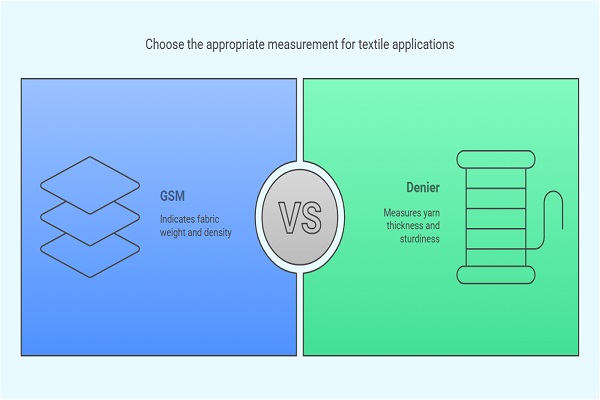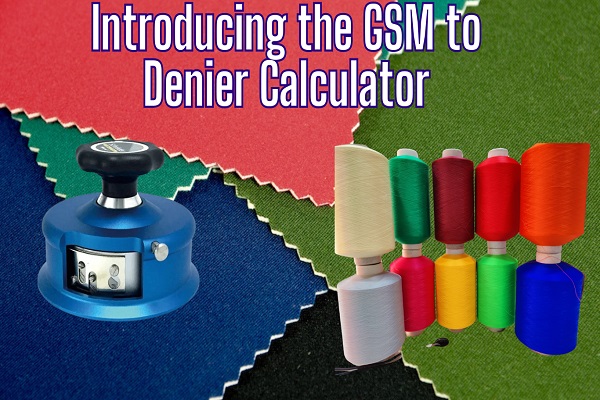GSM to Denier Calculator
© Yarn Count Ltd. All Rights Reserved.
Disclaimer: All tools in the Yarn Count have been reviewed by the relevant spinning industry experts.
The Formula for GSM to Denier Conversion
Denier = (GSM×9) ÷ (254 × Fabric Width (meters))
Where:
- GSM = Fabric weight in grams per square meter
- 9 = Conversion factor (fixed value)
- 254 = Constant derived from fabric calculations
- Fabric Width = Width of the fabric in meters
- Denier = The linear mass density of fibers (unit: grams per 9000 meters)
Table of Contents
Understanding GSM and Denier
In the textile industry, understanding the relationship between fabric weight and yarn thickness is crucial. Two commonly used units of measurement are Grams per Square Meter (GSM) and denier. Converting between these units helps in selecting appropriate materials for specific applications.

What is GSM?
GSM stands for Grams per Square Meter, indicating the weight of fabric in grams per one square meter. It reflects the fabric's density and thickness. Higher GSM values denote heavier and potentially more durable fabrics, while lower GSM values indicate lighter, more breathable materials.
What is Denier?
Denier measures the thickness of individual fibers or filaments in a yarn, defined as the mass in grams per 9,000 meters of the fiber. A higher denier signifies a thicker, sturdier fiber, whereas a lower denier indicates a finer, more delicate fiber.
Importance of Converting GSM to Denier
Converting GSM to denier is essential for textile engineers and manufacturers to ensure material compatibility and meet specific product requirements. This conversion aids in:
- Material Selection: Choosing the right yarn thickness for desired fabric weight.
- Quality Control: Maintaining consistency in fabric production.
- Product Development: Designing textiles that meet specific functional criteria.
The GSM to Denier Conversion Formula
The conversion between GSM and denier involves the following formula:
Denier = {GSM × Fabric Width (in meters) × 9000 } ÷ {Warp Density (ends per meter)+Weft Density (picks per meter)}Where:
- GSM: Fabric weight in grams per square meter.
- Fabric Width: Width of the fabric in meters.
- Warp Density: Number of warp threads per meter.
- Weft Density: Number of weft threads per meter.
This formula calculates the denier based on fabric weight and thread density, providing a precise measurement for textile applications.
Introducing the GSM to Denier Calculator
To simplify the conversion process, we present the GSM to Denier Calculator. This tool allows users to input fabric specifications and obtain accurate denier values instantly.

How to Use the Calculator
- Input GSM: Enter the fabric's weight in grams per square meter.
- Enter Fabric Width: Specify the width of the fabric in meters.
- Provide Warp Density: Input the number of warp threads per meter.
- Provide Weft Density: Input the number of weft threads per meter.
- Calculate: Click the 'Calculate' button to obtain the denier value.
This user-friendly interface ensures quick and accurate conversions, aiding in efficient textile production planning.
Practical Applications
Material Selection
Understanding the GSM and denier relationship assists in selecting appropriate materials for various textile products. For instance:
- Apparel: Lightweight fabrics (lower GSM and denier) for summer clothing.
- Home Textiles: Heavier fabrics (higher GSM and denier) for upholstery and curtains.
Quality Control
Maintaining consistent GSM and denier values ensures uniformity in fabric production, leading to high-quality end products.
Product Development
Designers can manipulate GSM and denier to create textiles with specific properties, such as enhanced durability or improved drapability, meeting diverse consumer needs.
Conclusion
Accurate conversion between GSM and denier is vital for textile professionals aiming to produce high-quality fabrics tailored to specific applications. The GSM to Denier Calculator serves as an essential tool in achieving precise measurements, facilitating informed decision-making in material selection, quality control, and product development.
By integrating this calculator into your workflow, you can enhance efficiency and ensure the production of textiles that meet exacting standards.